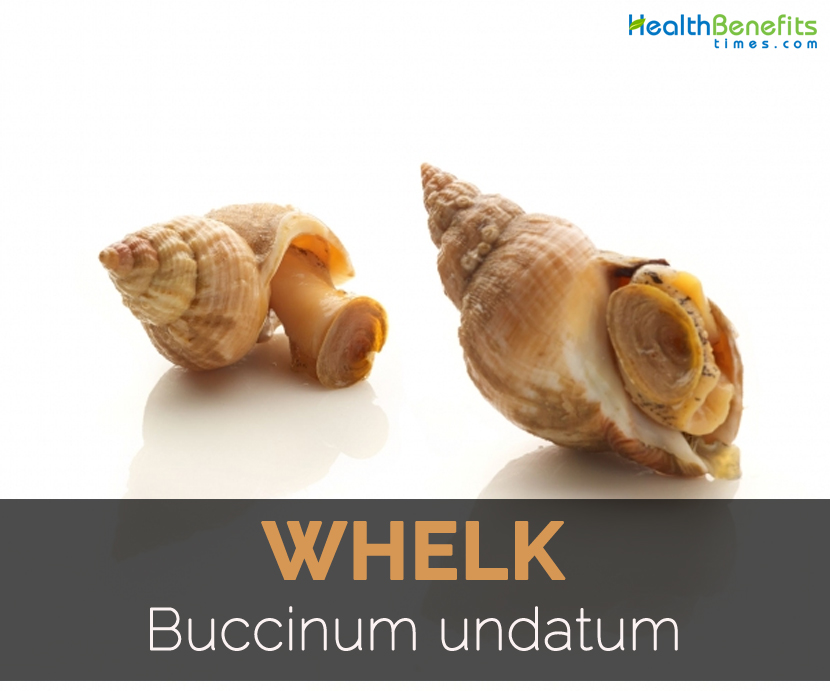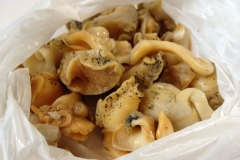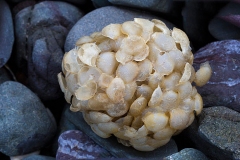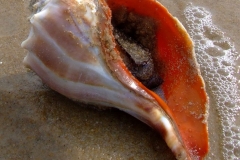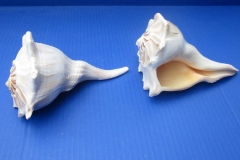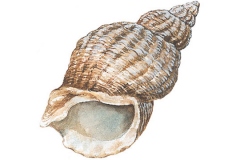| Whelk facts and health benefits Quick Facts | |
|---|---|
| Name: | Whelk facts and health benefits |
| Scientific Name: | Buccinum undatum |
| Origin | It belongs to normal benthic fauna of North Sea. It is found in sea at deeper depths. |
| Colors | Pale, white, reddish or yellowish |
| Shapes | Solid, ventricose, ovate-conical; Height: 10 cm; Width: 6 cm |
| Calories | 234 Kcal./cup |
| Major nutrients | Vitamin B-12 (642.50%) Copper (194.56%) Selenium (138.55%) Tryptophan (119.32%) Iron (106.88%) |
| Health benefits | Treat Alzheimer's, Slows aging process, Brain functions, Hair health, Transports oxygen |
| Name | Whelk |
|---|---|
| Scientific Name | Buccinum undatum |
| Native | It belongs to normal benthic fauna of North Sea. It is found in sea at deeper depths. It is available on France, United Kingdom, Iceland, Norway and other Northwest European countries. It is unable to survive above the temperature of 29°C and prefer colder temperatures |
| Common Names | Sea wash balls, Buckie, Common Northern Whelk, Common whelk, Sinuous whelk, Waved whelk, Waved buccinum |
| Name in Other Languages | Afrikaans: Wulk Albanian: Puçërr Arabic: حلزون [halzun] Armenian: Whelk Azerbaijani: Whelk Basque: Whelk Belarusian: вугор Bengali: Mukhēra braṇa (মুখের ব্রণ) Bosnian: Whelk Breton: Kilhog-mor Bulgarian: pŭpka (пъпка) Catalan: Buccino Cebuano: Whelk Chichewa: Whelk Chinese: Qīngchūn dòu (青春痘) Croatian: Whelk Czech: Whelk Danish: Konksnegl, Konk Deu: Gemeine Wellhornschnecke, Wellhorn, Wellhornschnecke Dutch: wulk, kinkhoorn English: Whelk, Common whelk, buckie, common northern whelk, common whelk, edible European whelk, waved whelk, whelk Esperanto: Whelk Estonian: Vinn Faroese: Agngágga Filipino: Welk Finnish: Torvisimpukka, Kuningaskotilo Fra: Buccin commun, buccin ondé, buccin, bulot, comteux French: Buccin, buccin commun, buccin ondé, Bulot, comteux Galician: Bucios Georgian: Whelk German: Wellhornschnecke, Wellhorn Greek: Eídos speiroeidoús konchýliou (είδος σπειροειδούς κογχύλιου) Gujarati: Gōkaḷagāya jēvī śaṅkhalāmāṁ rahētī dariyā’i māchalī (ગોકળગાય જેવી શંખલામાં રહેતી દરિયાઇ માછલી) Haitian Creole: Buksen Hausa: Whelk Hindi: Vilk (विल्क) Hebrew: Shblul (שַׁבְּלוּל) Hmong: Whelk Hungarian: Ehető kürtös csiga, Közönséges kürtcsiga Icelandic: Whelk, Beitukóngur Igbo: Whelk Indonesian: Jerawat Irish: Cuachma Italian: Buccino, Buccina, Buccinum undatum, buccino comune Japanese: Ko katamari (小塊) Javanese: Whelk Kannada: Śaṅkha mīnu (ಶಂಖ ಮೀನು) Kazakh: Whelk Khmer: Whelk Korean: Ppyoluji (뾰루지) Latin: Whelk Lao: Whelk Latvian: Molusks Lithuanian: Bukcina Macedonian: Whelk Malagasy: Whelk Malay: Whelk Malayalam: Vhelk (വ്ഹെല്ക്) Maltese: Bronja Maori: Whelk Marathi: Cābakācā kinvā chaḍīcā vaḷa (चाबकाचा किंवा छडीचा वळ) Mongolian: Whelk Myanmar (Burmese): Whelk Nepali: Whelk Norwegian: Whelk, kongsnegl, kongsnigel Persian: صدف حلزونی, حلزون نفیر معمولی Polish: Trądzik, Trąbik zwyczajny Portuguese: Whelk, Buzo, Búzio Romanian: Melc de mare Russian: Pryshch (прыщ), Obyknovennyy buktsinum (Обыкновенный букцинум) Serbian: Vhelk (вхелк) Sesotho: Whelk Sinhala: Whelk Slovak: Pupienok Slovenian: Valovita blatarka Somali: Whelk Spanish: Buccino, Bocina, Caracolillo de Bruselas Swahili: Whelk Swedish: Whelk, Valthornssnäcka Tajik: Whelk Tamil: Mukapparu (முகப்பரு) Telugu: Whelk Thai: H̄xy ḥwĕlkh (หอยฮเว็ลค) Turkish: Deniz salyangozu, Salyangoz Ukrainian: Pryshch (прищ) Urdu: Whelk Uzbek: Bo’jama Vietnamese: Whelk Welsh: Cregyn moch Yiddish: ווהעלק Yoruba: Whelk Zulu: Whelk |
| Habitat | Carnivorous, neogastropod mollusc |
| Feeds On | Polychaete worms, bivalves, mussels |
| Breeding | October-May |
| Lifespan | 10 years |
| Predators | Cod, sea stars, wolfish, man |
| Shape & Size | Solid, ventricose, ovate-conical; Height: 10 cm; Width: 6 cm |
| Shell Color | Pale, white, reddish or yellowish |
| Whorls | 7-8, convex, crossed by oblique folds, waved, thick |
| Major Nutrition | Vitamin B-12 (Cobalamine) 15.42 µg (642.50%) Copper, Cu 1.751 mg (194.56%) Selenium, Se 76.2 µg (138.55%) Tryptophan 0.525 g (119.32%) Iron, Fe 8.55 mg (106.88%) Threonine 1.816 g (103.18%) Leucine 3.236 g (87.55%) Isoleucine 1.407 g (84.15%) Valine 1.764 g (83.52%) Protein 40.53 g (81.06%) |
| Health Benefits |
|
| Calories in 3 oz. (85 gm.) | 234 Kcal. |
| Precautions |
|
| How to Eat |
|
| Other Facts |
|
Nutritional value
A serving size of 85 grams of whelk contains 27.2 g of moisture, 234 calories, 40.53 of protein, 0.68 g of total lipid fat, 3.4 g of ash and 13.19 g of carbohydrate. It also offers 642.50% of DV of Vitamin B12, 194.56% of DV of copper, 138.55% of selenium, 119.32% of tryptophan, 106.88% of DV of iron, 103.18% of threonine, 87.55% of DV of leucine, 84.15% of DV of isoleucine, 83.52% of DV of valine, 81.06% of DV of protein, 74.46% of DV of lysine, 67.37% of DV of histidine, 42.46% of DV of vitamin B6, 34.76%of DV of magnesium, 34.29% of DV of phosphorus, 32.91% of manganese, 25.18% of DV of zinc, 23.33% of DV of sodium, 14% of DV of riboflavin, 12.55% of DV of potassium, 10.60% of niacin and 10.15% of carbohydrate.
Habitat
Finding a whelk depends on the species you’re looking for. In general, whelks may be found in many parts of the world, and are typically found on sandy or muddy bottoms, from shallow tide pools out to waters several hundred feet deep.
Feeding
As we all know that Whelks are carnivores, and normally feed on crustaceans, mollusks, worms and even eat other whelks. They can drill a hole into the shell of their prey with their radula, or may wrap their foot around the hinged shells of their prey and use their own shell as a wedge to force the shells open, then insert their proboscis into the shell and consume the animal inside.
Reproduction
Whelks reproduce by sexual reproduction with internal fertilization. Some, like the channeled and knobbed whelks, produce a string of egg capsules that maybe 2-3 feet long, and each capsule has 20-100 eggs inside which hatch into miniature whelks. Waved whelks produce a mass of egg capsules which look like a pile of egg cases.
The egg capsule allows the young whelk embryos to develop and provides protection. Once they have developed, the eggs hatch inside the capsule, and the juvenile whelks leave via an opening.
Health Benefits of Whelk
Whelk is an excellent source of essential fatty acids that prevents the chances of cancer, heart ailments if consumed in moderate amounts. The seafood lovers would like this. It provides vitamins, proteins and minerals along with low amount of fat. It does not increase the cholesterol of blood. Due to the low content of calories, it is effective for weight loss.
1. Treat Alzheimer’s
Cobalamine helps to treat Alzheimer’s disease which shows the symptoms such as cognitive degeneration and confusion. The study shows that Alzheimer’s patients has low content of Vitamin B12 in the body. (1)
2. Slows aging process
Copper helps to prevent cell membrane from the damage of free radicals which attack organs that are the cause for age spots, wrinkles, macular degeneration, cancer and kidney ailments. (2)
3. Brain functions
Iron helps to increase the development of brain. It aids the supply of oxygen to the brain as it uses about 20% of oxygen. It promotes the cognitive activity and formation of neural pathways that helps to prevent from Alzheimer’s disease and dementia. The adequate intake of iron as well as oxygenation of brain is vital. (3)
4. Hair health
Protein maintains the hair health and prevents its damage. The study shows that it is essential for the growth of hairs. With its benefits, it is used in conditioners. (4) (5)
5. Transports oxygen
Iron assists in transporting oxygen to the body cells which assist the organs to perform its various functions. (6)
6. Strengthen immunity
Pyridoxine is essential for the immune health in the body. It assists the body to prevent infections which could be victimized in the deficiency of Vitamin B6. (7)
7. Prevent cramps
Magnesium helps to relax kidney stress, muscular tension and back muscles. Its deficiency could cause leg cramps and fatigue. The adequate intake of magnesium helps to treat chronic leg cramps. (8)
8. Repair cells
It helps to repair the body cells from the wear and tear. It promotes the body cells which is essential for the overall health. It helps to form protein and stimulate hormones. (9)
9. Eliminate free radicals
Manganese has antioxidant properties which monitor the free radicals activity that damage human cells and cause cancer. The supplements help to prevent these health conditions. (10)
10. Provides energy
Vitamin B2 is vital for the energy production by supporting metabolism of proteins, carbohydrates and fats. (11)
Different Human Uses
Whelks are a popular food. People eat the mollusks’ muscular foot—an example is the Italian dish scungilli, which is made from a whelk’s foot. These animals are also collected for the seashell trade. They may be caught as bycatch (e.g., in lobster traps), and they may be used as bait to catch other marine life, such as cod. Whelk egg cases may be used as a “fishermen’s soap.”
The veined rapa whelk is a non-indigenous species that have been introduced into the U.S. The native habitat of these whelks includes waters in the western Pacific Ocean including the Sea of Japan, Yellow Sea, East China Sea, and the Bohai Sea. These whelks were introduced into the Chesapeake Bay and may cause damage to native species.
Precautions
- The toxic gland should be removed before consumption.
- It should be consumed in limited amounts carefully.
- The people who are allergic to seafood should avoid it.
http://www.fisheries.is/main-species/invertebrates/common-whelk/
How to Eat
- In Japan, it is used for making sushi and sashimi.
- In Vietnam, it is used to make Bún ốc – vermicelli.
- In Korea, it is served with cold noodles and salad.
- It is also served with alcohols as side dish.
- In Vietnam, it is served with the sea snails.
- It is consumed by sprinkling vinegar and with butter or slice of bread.
Other Facts
- The whelk’s color is dependent on the food it eats.
- It is mostly confused with Conchs due to the similar appearance.
References:
www.shellfish.org.uk/files/Healthy-Eating/SAGB-whelks-factsheet-final.pdf
http://eol.org/pages/595071/overview
https://www.itis.gov/servlet/SingleRpt/SingleRpt?search_topic=TSN&search_value=73795#null
https://en.wikipedia.org/wiki/Whelk
http://www.bbc.co.uk/food/whelk
http://barnegatshellfish.org/whelk01.htm


